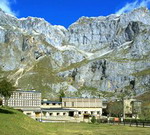The Paradores
of Asturias, Cantabria, Navarra and Basque Regions, Spain

| Asturias
- Cangas de Onís |
|

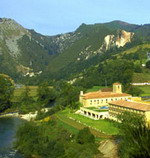 |
Parador
de Cangas de Onis
Monastery of San Pedro de
Villanueva (12th C to 18th C). Tradition has it that King Alfonso I 'The
Catholic' constructed this building on 21 February 746, and the excavations
carried out at the start of the refurbishing work to turn it into a Parador
de Turismo confirm this idea. The current monastery was founded on this
site and run by the Order of San Benito until the Desamortización
de 1835 (Large-scale selling of State and Church assets). Two rooms
with archeological remains, pottery in particular, uncovered during the
refurbishing work are testament to this distant past. The monastery
was declared a National Monument in 1907, and features an added wing of
perfectly harmonious architectural and constructional qualities: truly
a jewel set on the green banks of the River Sella, in whose waters the
hotel is reflected. In the background, guests can contemplate the majestic
landscape of the Picos de Europa. |


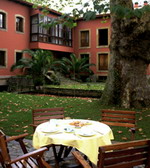 |
Parador
de Gijon, Gijon
The Parador occupies hundred-year-old
mill, located in the Isabel La Católica Park, one of the most beautiful
spots in the town of Gijón. It has a beautiful pond, which offers
great harmony and tranquility. The closeness of San Lorenzo beach and of
the Cimadevilla sailors' quarter, convert it into an ideal place to enjoy
unforgettable days. It has a spacious, friendly and bright interior
which recreates the warmth of the setting in bedrooms and common rooms,
while the closeness of the sea can be felt from their windows. 'Fabada'
(rich stew of beans, pork, etc.) is the dining room's star dish, although
beans ('fabes') are included in other preparations. The 'caldereta de marisco'
(seafood stew), 'chopa a la sidra' (fish in cider), 'pote asturiano' (vegetable
and pork broth) and 'merluza con cocochas' (hake) also stand out. The dessert
menu includes rice pudding, 'frixuelos' (cream-filled crepes) and 'casadielles'
(fried sweet with dried fruit). |

| Basque
Region (Pais Vasco) - Hondarribia - Guipúzcoa |
|

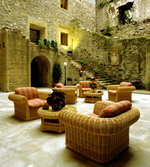 |
Parador
de Hondarribia, Hondarribia, Guipúzcoa
Founded by the Navarrese
king Sancho Abarca in the 10th c., this Parador rises up in a beautiful
castle which maintains the structure of a medieval fortress in a monumental,
coastal setting. Its defensive appearance, with thick walls, conceals an
interior recovered with mastery. The immense, naked stone of the
courtyard stands out, as do the beautiful views of the French coast and
the sea, which the guest can contemplate from the splendid terrace or from
some bedrooms. Beautiful nooks and crannies, spaces adorned with arches,
wrought iron and coffered ceilings envelop the traveller in an atmosphere
of indescribable beauty. Lances, cannons and armour make up the interior
decoration, offering an air of elegance in a most comfortable atmosphere.
The Parador does not have a restaurant, but there are many excellent places
to eat nearby. Remember to ask at the Parador. We will be happy to make
a recommendation ... A buffet breakfast is served to registered guests. |


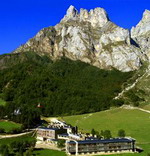 |
Parador
Fuente Dé, Fuente Dé, Santander Province
This modern mountain refuge
located on the foothills of the Picos de Europa and opening onto the fertile
Liébana valley, shows nature in total freedom. It is surrounded
by the dramatic slopes of the Picos de Europa, woods and hillsides, in
a region which is split into modest hamlets. The building is located at
the bottom of the cable car which goes up to the Áliva viewpoint,
at a privileged meeting point for lovers of outdoor activities. The classical
mountain style and the warm wood and leather furniture recreate the much-appreciated
home warmth, to which are added the homemade dishes of traditional Cantabria
cuisine. This is an ideal shelter for mountaineers and hunters, where
you will enjoy the traditional Cantabrian cuisine. With such dishes as
Liébana stew, cockerel salad, sirloin steak with Tresviso cheese,
venison with blueberries sauce, veal chop, and tea mousse. |


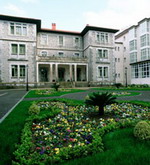 |
Parador
de Limpias (Cantabria)
The new Parador in Limpias
is located in the Palace of Eguilior estate, which was the summer headquarters
of King Alfonso XIII's Council. The palace belonged to Don Manuel de Eguilior,
the Count of Albox, and is attributed to the architect Emilio de la Torriente.
Rooms are large in size, decorated in a classical way, not forgetting any
details of modern facilities. Restaurant is well decorated in a classical
style. Dishes such as marmita de bonito (stew made with bonito tuna)
cocido montanes (traditional white bean and pork sausage stew), other white
and red bean stews, plus a variety of cheeses, and sweets such as the famous
Corbatas de Unquera, sobaos pasiegos, or Pantortillas de Reinosa are just
a few of the delights diners will enjoy. The palace is a large square
building with four pseudo-towers at each corner, none of which is very
high. |

| Cantabria
- Santillana del Mar |
|

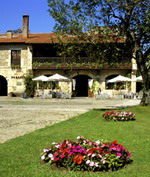 |
Parador
de Santillana, Santillana del Mar
This newly built manor house
conserves the typical architecture of the area, blending in perfectly with
the architectural surroundings of this beautiful locale. Comfortable rooms
with a pleasant atmosphere help the guest to find peacefulness and rest.
The restaurant and bar, located in the Parador Santillana Gil Blas offer
guests the opportunity to sample Cantabrian cuisine's most traditional
dishes. We strongly recommend you the 'cocido montañés':
a dish of boiled white beans, vegetables, bacon and sausages... Also enjoy
the grilled sirloin steak with Tresviso sauce, Cantabrian hakefish with
green asparagus, 'sorropotún', and 'quesada' (kind of pudding). |
 |
|
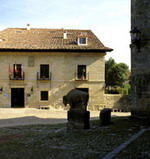 |
Parador
de Santillana Gil Blas Santander Province
The
Parador is installed in the beautiful Barreda-Bracho ancestral home, in
the Santillana del Mar plaza, a town declared a National Monument, whose
origins date back to the 8th century. The main entrance precedes diaphanous,
friendly rooms, with wooden floors and traditional decoration for the furniture
and the ornamental details. The bedrooms are comfortable and in harmony
with the Parador's overall atmosphere. The dining room serves highland
and Liébana stews, grilled baby beef sirloin, hake from the Cantabrian
Sea over green asparagus, the famous 'sorropotún' (bonito and vegetable
stew), and the typical dessert 'quesada pasiega' (cheese pastry). |

| Navarra
- Alava - Argomaniz |
|

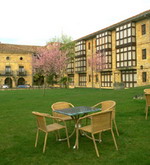 |
Parador
de Argomaniz, Alava - Argomaniz
The Parador occupies a splendid
Renaissance palace, from which it dominates the natural beauty of the Plains
of Álava, the Gorbea mountain range and the Ullibarri Gamboa reservoir.
The surroundings invite you to wander around the small, pleasant village
of Argómaniz, also ideal for enjoying the beautiful natural spaces.
The palace, where Napoleon regained his strength before attacking the town
of Vitoria, boasts the Larrea family coat of arms on the façade
of the building and a wonderful interior atmosphere, with the spacious
living rooms standing out. The rest of the common rooms, floors, furniture,
large chests and other details are enhanced by the charm of its wood, a
noble material which is also present in its unequalled dining room. It
offers traditional recipes, including dishes such as 'perretxikos' (mushrooms),
snails and 'goxua', a sponge cake with cream, whipped cream and caramel. |

| Navarra
(Navarre) - Olite |
|

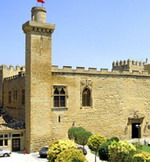 |
Parador
de Olite, Olite, Navarra
Parador de Olite The
Parador occupies one of the wings of the majestic 15th C. palace-castle,
declared a National Monument, on which the towers and battlements stand
out. In keeping with its medieval setting, it rises up on solid stone walls
and offers a glimpse of the numerous historical adventures it lived through
in other times, such as the holding of parliament under the government
of the Noble King. The medieval spirit is maintained on the inside, with
very beautiful stained glass windows on the staircase and in the dining
room, arcades and ornamental details such as armour, rugs, wrought iron
lamps and wooden coffered ceilings. The restaurant offers an excellent
display of local products: the fresh asparagus and 'piquillo' peppers stand
out. |
[ Andalucía
][ Aragón ][ Asturias
]] Basque Region ][ Canary Islands
][ Cantabria ][ Castilla
La Mancha ][ Castilla y Leon ]
[ Cataluña
][ Extremadura ][ Galicia
][ La Rioja][ Madrid
][ Murcia ][ Navarra
]
[ Spanish
North Africa ][ Valencian Community ]
|

